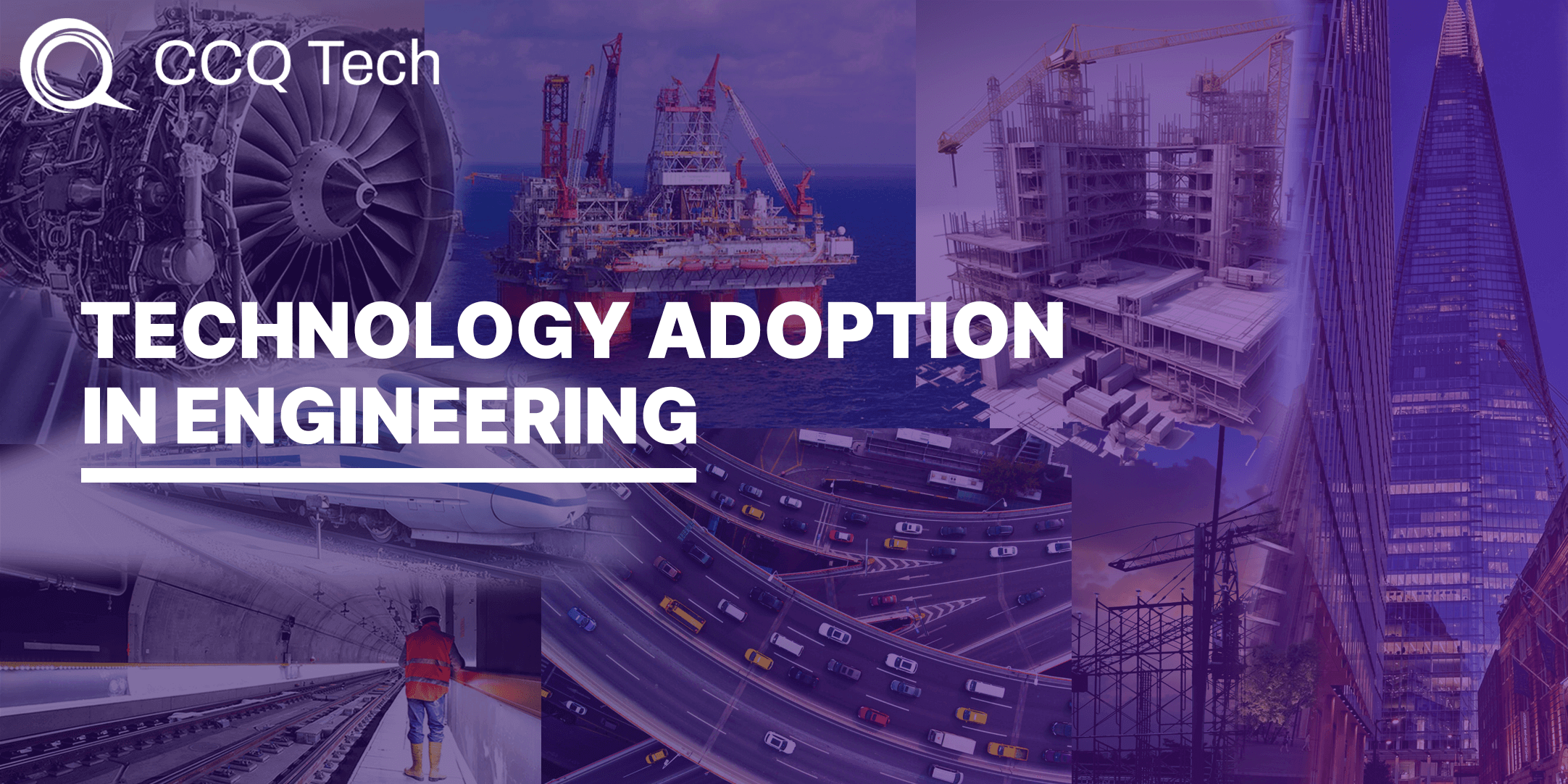
The engineering sector, long known for its reliance on established practices and meticulous calculations, continues to be impacted by technological innovation. This rapid evolution is reshaping the global landscape, presenting both challenges and opportunities for SME engineering firms.
From artificial intelligence (AI), integrated tools sets to sustainability, companies are presented with a wealth of opportunities to streamline processes, gain valuable insights, and enhance their competitive advantage.
But how does successful technology adoption go beyond simply acquiring the latest cloud platforms and software updates? Several key challenges need addressing to ensure a smooth and successful implementation in a digital age.
Here are the key takeaways from our latest engineering technology roundtable joined by 7 senior directors of UK engineering firms.
Building the Business Case

Adopting new digital solutions requires technological readiness and a focused business rationale for adoption. The group discussed a key to successful technology adoption lies in developing a clear, compelling business case.
To develop the case it may be useful to undertake a proof of concept project or develop a Minimum Viable Product (MVP). These can enable firms to ‘test the waters’ with a basic, functional solution that demonstrates feasibility and potential return on investment before committing to the adoption of new technology.
A director from the roundtable emphasised the need for discipline in defining the MVP, stating, “Engineers often want every feature under the sun. We need to build that first simple solution, validate it, and then scale.” This approach mitigates risk and provide tangible evidence that can garner stakeholder buy-in. CCQ Tech further this statement by adding that even very early releases of new technology can provide a demonstrable useful change and thus a platform the iterate and evolve.
For many SMEs, the financial aspect of adopting new technologies is daunting. Developing a compelling business case for such investments is often complicated by the distribution of costs and benefits. “The difficulty lies in quantifying the intangible benefits and convincing stakeholders of the long-term gains versus the upfront costs” an attendee elaborated. Effective business cases must clearly articulate the value of the investment, balancing immediate costs with future savings and efficiency gains (or other success criteria).
Navigating Software Lifecycle Challenges

The lifecycle of software—from onboarding to decommissioning—poses challenges, particularly in an environment where multiple software solutions are in play. The roundtable highlighted the complexities of integrating and managing multiple software packages & updates, each with its learning curve and integration demands. Insights from experience were shared about the complications in offices where personal preferences impact project management and productivity. For example a design director with 20 years of experience working in engineering technology stated: “If other departments use software I am not familiar with then verifying work becomes a challenge. Sometimes I am sent important design data I cannot even access because I don’t have the right software installed or licensed wasting time“.
The group noted that sometimes engineering teams are forced to use software that may not be their first choice (either by client or the business), complicating project management and impacting productivity. Further, users often regress back to the tools they are familiar leading to multiple versions of designs, plans and project information. One solution is integrating data flows and different software/cloud platform environments. However, anyone with experience connecting Office365 with say Bluebeam or say CAD products using tools like Zapier knows it is not easy to create efficient, stable automations. Leveraging APIs and Python scripts as another example is also not as simple as they seem. Regardless of the difficulty, there are clear productivity and project management advantages to being able to integrate systems and workflows into engineering practices especially where ‘change’ occurs frequently during a project’s life.
AI, Automation and Skillsets

AI and machine learning are transforming engineering fields that require high precision by automating calculations and data analysis. The potential to create structured databases from traditionally unstructured data (e.g., collate handwritten notes, PDFs, and CAD drawings) was a great idea tabled by a computational engineer in the room. The importance of obtaining precise answers in structural engineering is vital for safety so is there room for taking historical answers and assumptions and using generative AI to leverage business experience and support future projects?
Furthering the point about precision a critical concern is the accuracy of results derived from AI and other software tools. Safety cannot be compromised and inaccurate data can lead to costly mistakes.
Attendees expressed concerns about the dependability of AI-generated outputs, shedding light on the ongoing need for skilled engineers to interpret and verify results. The discussion underscored the need for robust verification processes to ensure that technology outputs are reliable and accurate. This touches on something that CCQ is observing across industries namely, that new skillsets and job roles are being created. It seems inevitable that businesses use more and more AI tools (predictive, generative or other) therefore the skills required to know what questions to ask of AI, understand which models and datasets to ruse, and how to verify the accuracy of results is a high priority.
As pointed out by a director, “The technology is only as good as the people behind it. We need ongoing education and upskilling to ensure our teams can fully leverage these tools. This skills gap poses a challenge but also an opportunity for SMEs to invest in their workforce and enhance their capabilities (and point of differentiation) further.”
Despite the advancements in AI and automation, the roundtable unanimously agreed that human skills remain indispensable. Another director noted, “AI isn’t going to replace engineers anytime soon. It’s about enhancing our capabilities, not supplanting them.”
Sustainability in Engineering

Sustainability in engineering refers to designing and implementing solutions that effectively balance environmental, social, and economic demands to ensure resource availability for future generations. This involves creating systems and processes that are efficient, environmentally friendly, and socially responsible (ESG).
Sustainability is becoming increasingly critical, with carbon calculators at the forefront of many discussions. One attendee stated “The Carbon element is topical. Our discipline has to accommodate that and we are creating our own software to understand it.”
At the core of sustainable engineering practices is verifying carbon calculations. These detailed assessments measure the carbon emissions associated with engineering activities, from the production of materials to the operational phase of a project. Results are crucial for ensuring compliance with environmental regulations and for helping firms to manage and mitigate their environmental impact. Verified carbon calculations follow strict standards and methodologies to ensure accuracy and reliability but the process of verification is a huge problem. With sometimes dozens of different firms involved in supply chains including anything from importing cars to designing and constructing buildings how can embodied and operational carbon be effectively calculated?
As many of the business leaders in attendance pointed out, the accuracy of these calculations often depends on factors beyond the direct control of engineering firms, such as varying material properties and environmental impacts. The discussion highlighted the need for software that can adapt to new regulations and provide trustworthy data. “Carbon calculations are complex and subject to many external factors, making certainty difficult to achieve,” explained an attendee.
The industry is moving towards more sophisticated, verifiable methods to ensure that sustainability metrics are not only accurate but also meaningful. This shift is not just about compliance but is a core part of how firms are beginning to redefine their value propositions in a greener economy.
CCQ have built carbon calculators and a director in the room runs a consultancy geared specifically towards this topic. Reach out to [email protected] with your questions on this, or for more information and contact details.
Conclusion: Engineering the Future

While there are significant hurdles to overcome – from building strong business cases, managing data, to implementing the right AI models & approaches – the future of engineering inevitably involves emerging technology.
The journey towards full integration is paved with challenges that demand not only innovative solutions but also a deep understanding of the field’s core requirements. For engineering leaders, the path forward involves a blend of cautious innovation, rigorous validation, and an unwavering commitment to sustainability and efficiency.
By fostering a culture that embraces change while respecting the demands of the field, engineering firms can position themselves to adapt and thrive in a digital era. The insights shared at the roundtable uncover avenues of discussion and the beginning of strategies to help navigate the complexities of technology adoption, ensuring that today’s solutions do not become tomorrow’s obstacles.
The ability to streamline workflows, optimise designs, ensure regulatory compliance, and contribute to a sustainable future makes the adoption of right-fit technology an imperative for the sector. By addressing the human element of change, fostering workable AI tactics, and prioritising data management, engineering firms can harness the power of their people to uplift service speed, quality and safety.
To explore real-world examples of how our innovative solutions have transformed engineering practices, check out our engineering case studies.
Also, don’t miss our upcoming manufacturing event, where we’ll delve deeper into the latest technological advancements and how they are reshaping the future of the manufacturing sector. Visit our Eventbrite page for more details.
If you have any questions about software, cloud, digital transformation, digital twins or bespoke technology email us at [email protected].
CCQ Tech would like to extend our thanks and gratitude to Valentina Galmozzi, Megan Greig, Craig Lester, Neel Anand MBA, CEng, MICE, MAPM, Nick Keegan PMVE CEM CMVP, Gordon Rankine, Tom Leake and Robert Lange for sharing their time, experience and valuable industry insights.
